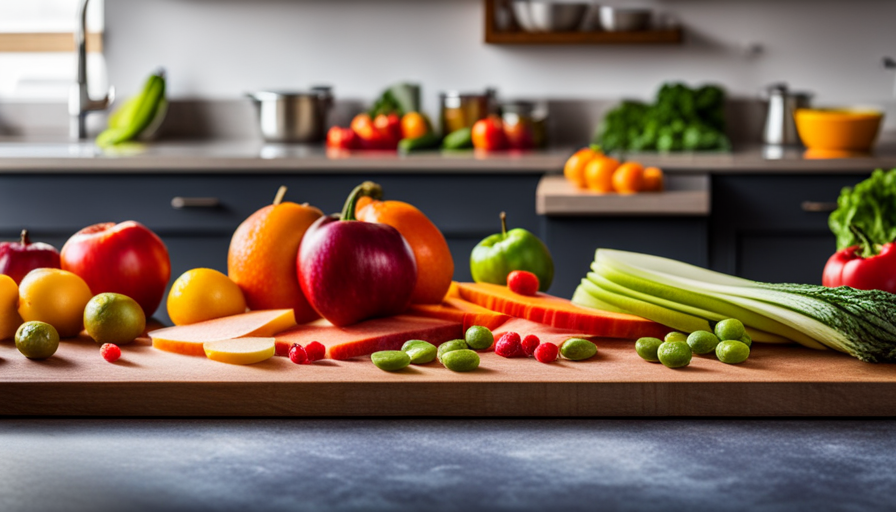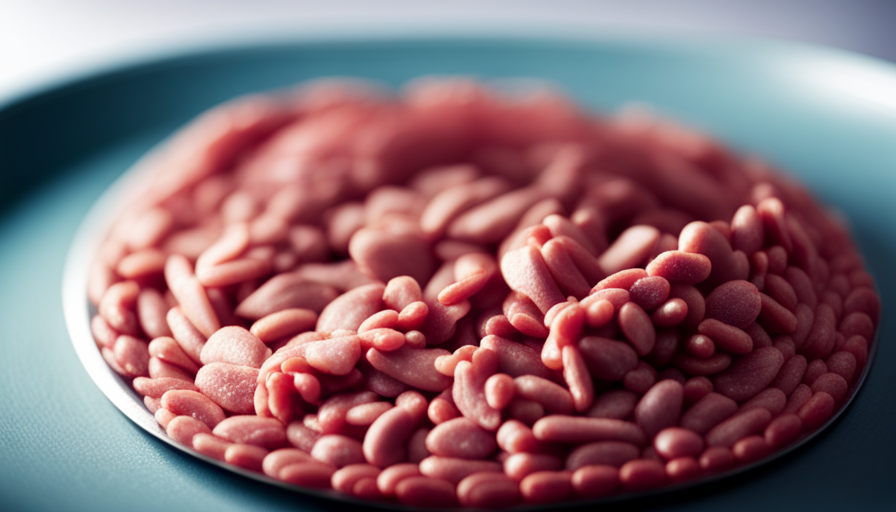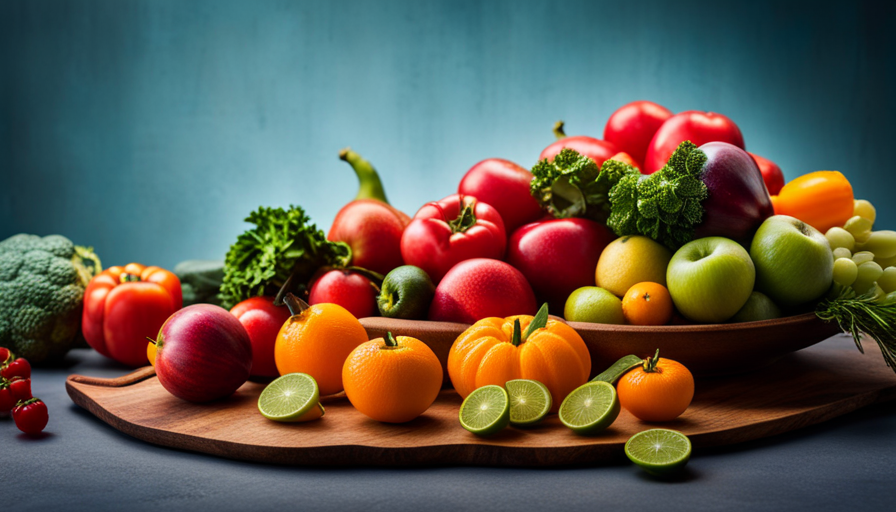Are you prepared to explore the realm of raw food and discover the amazing advantages it provides?
Just like a vibrant garden bursting with life, a raw food diet can nourish your body and awaken your senses. By incorporating raw fruits, vegetables, nuts, seeds, and superfoods into your meals, you can unlock a world of vibrant flavors, abundant nutrients, and optimal health.
But where do you start? In this article, we will guide you on a journey to discover the secrets of eating enough raw food. From transitioning to a raw food diet to meal planning and preparation, we will provide you with practical tips and evidence-based information to help you navigate this exciting and transformative way of eating.
Get ready to nourish your body, ignite your taste buds, and embrace the power of raw food!
Key Takeaways
- Gradually add more raw fruits and vegetables to meals
- Experiment with raw food recipes
- Incorporate raw snacks into the day
- Decrease intake of cooked foods gradually
Understanding the Benefits of Raw Food
If you’re looking for a delicious way to boost your health, raw food is where it’s at! Understanding the importance of enzymes in raw food and the impact of cooking on nutrient loss in food is key to making the most out of your raw food journey.
Enzymes are essential for our bodies to function properly. They help with digestion, metabolism, and overall health. Raw food is abundant in enzymes because they’re not destroyed by cooking. When we cook food, especially at high temperatures, the heat can denature or break down these enzymes, reducing their effectiveness.
By eating raw food, you ensure that you’re getting the full benefits of these enzymes, aiding in digestion and nutrient absorption.
Cooking can also lead to nutrient loss in food. Certain vitamins and minerals, such as vitamin C and B vitamins, are heat-sensitive and can be destroyed during the cooking process. Raw food, on the other hand, retains these nutrients, providing you with a higher concentration of essential vitamins and minerals.
Incorporating more raw food into your diet can be a game-changer for your health. Not only do you get the full benefits of enzymes, but you also retain more nutrients. So go ahead and start incorporating raw fruits, vegetables, nuts, and seeds into your meals. Your body will thank you for it!
Transitioning to a Raw Food Diet
When transitioning to a raw food diet, it’s important to gradually incorporate more uncooked options into your meals. This will help your body adjust to the new way of eating and ensure that you’re getting enough nutrients. Here are some tips to make the transition easier:
-
Start by adding more raw fruits and vegetables to your meals. You can have a side salad with your lunch or include raw veggies in your stir-fry.
-
Experiment with raw food recipes. There are plenty of delicious and nutritious options out there, from zucchini noodles to raw vegan desserts. Look for recipes that include ingredients you enjoy and give them a try.
-
Incorporate more raw snacks into your day. Instead of reaching for a bag of chips, try munching on some raw nuts, seeds, or fruits. These’ll provide you with energy and nutrients to keep you going.
-
Gradually decrease your intake of cooked foods. Start by replacing one cooked meal a day with a raw option and gradually increase from there.
-
Stay hydrated. Drinking plenty of water is important when transitioning to a raw food diet, as raw fruits and vegetables contain a lot of water that can help keep you hydrated.
By following these transitioning tips and trying out raw food recipes, you can ensure that you’re getting enough raw food in your diet while enjoying delicious and nutritious meals.
Incorporating Raw Fruits and Vegetables
To fully embrace a raw food diet, you’ll love discovering the variety of flavors and textures that raw fruits and vegetables offer. There are over 2,000 different types to choose from. Incorporating raw fruits and vegetables into your daily meals is an excellent way to increase your intake of essential vitamins, minerals, and antioxidants.
One simple and delicious way to enjoy raw fruits and vegetables is by making raw food smoothies. These nutrient-packed beverages can be made by blending together a combination of fruits, vegetables, and a liquid base like coconut water or almond milk. You can get creative with your smoothie recipes, adding in ingredients like spinach, kale, berries, and bananas for added nutrition and flavor.
In addition to smoothies, raw fruits and vegetables can also be enjoyed as snacks throughout the day. They are the perfect choice for a quick and nutritious pick-me-up. You can slice up some fresh cucumbers, bell peppers, or carrots and pair them with a raw food dip like guacamole or hummus. Another option is to snack on raw fruits like apples, grapes, or oranges, which provide natural sweetness and a satisfying crunch.
By incorporating these raw fruits and vegetables into your meals and snacks, you’ll not only boost your nutrient intake but also enhance the overall taste and variety of your raw food diet.
Exploring Raw Nuts and Seeds
Incorporating raw nuts and seeds into your diet can provide a rich source of essential fatty acids and protein, giving you a satisfying and nutritious boost to your meals and snacks. These nutrient powerhouses offer a multitude of health benefits, making them a valuable addition to any raw food diet.
Raw nuts, such as almonds, walnuts, and cashews, are packed with heart-healthy fats, fiber, and a variety of vitamins and minerals. They’ve been shown to improve cardiovascular health, reduce inflammation, and support brain function. Consuming a handful of raw nuts daily can help you meet your daily nutrient needs and keep you feeling energized throughout the day.
Raw seeds, like chia, flax, and pumpkin seeds, are also incredibly nutritious. They’re rich in omega-3 fatty acids, which are essential for brain health, and they’re a great source of plant-based protein. These small but mighty seeds can be sprinkled on top of salads, added to smoothies, or used as a crunchy topping for yogurt or oatmeal.
To incorporate raw nuts and seeds into your meals, get creative with recipes. Try making a homemade trail mix with a variety of raw nuts and seeds, or blend them into a creamy nut butter. You can also use them as a base for energy balls or sprinkle them on top of roasted vegetables for added crunch.
Raw nuts and seeds are a fantastic addition to a raw food diet. They offer numerous health benefits and can be incorporated into a variety of creative recipes. So go ahead and enjoy the goodness of these nutrient powerhouses in your meals and snacks.
Adding Raw Superfoods to Your Meals
Boost your meals with the incredible power of raw superfoods, adding a burst of vitality and nourishment to fuel your body and ignite your taste buds. Incorporating raw superfoods into your meals is a great way to boost your nutrient intake and add variety to your diet.
Here are four ways to incorporate raw superfoods into your meals:
-
Make raw superfood smoothies: Blend together a variety of raw superfoods like spinach, kale, berries, and chia seeds to create a nutrient-packed smoothie. These smoothies aren’t just delicious but also provide a great way to get your daily dose of vitamins and minerals.
-
Add raw cacao to your recipes: Raw cacao is a powerful superfood that’s high in antioxidants and can help improve your mood. Add a tablespoon of raw cacao powder to your favorite smoothie, oatmeal, or homemade energy bars for a rich chocolate flavor.
-
Sprinkle raw hemp seeds on your salads: Hemp seeds are a great source of plant-based protein, omega-3 fatty acids, and fiber. Sprinkle a handful of raw hemp seeds on top of your salads to add a nutty flavor and boost the nutritional content of your meal.
-
Top your meals with goji berries: Goji berries are packed with antioxidants, vitamins, and minerals. Sprinkle a handful of raw goji berries on top of your breakfast cereal, yogurt, or desserts for a sweet and tangy flavor.
By incorporating these raw superfoods into your meals, you can enjoy a variety of flavors while nourishing your body with essential nutrients.
Creating Flavorful Raw Sauces and Dressings
Now that you’ve learned how to incorporate raw superfoods into your meals, let’s dive into the world of creating flavorful raw sauces and dressings. These condiments won’t only add a burst of taste to your dishes but also enhance the nutritional value of your raw food.
When it comes to creating flavorful raw sauces and dressings, the key lies in combining the right ingredients to achieve a harmonious balance of flavors. Experiment with a variety of fruits, vegetables, herbs, and spices to find your perfect raw food flavor combinations.
Consider using ingredients like avocados, tomatoes, lemon or lime juice, fresh herbs like basil or cilantro, and spices such as garlic or ginger. These ingredients won’t only add depth and complexity to your sauces but also provide a host of health benefits.
Blend these ingredients together in a high-speed blender or food processor until smooth and creamy. You can adjust the consistency by adding water or extra virgin olive oil. Don’t be afraid to get creative and try different combinations until you find your favorite flavors.
By incorporating flavorful raw condiments into your meals, you won’t only satisfy your taste buds but also provide your body with a wide range of essential nutrients. So go ahead and get adventurous in the kitchen, and enjoy the vibrant flavors of raw sauces and dressings on your raw food journey.
Raw Food Meal Planning and Preparation
Get ready to embark on a culinary adventure as we explore the art of planning and preparing delicious meals using the power of raw ingredients. When it comes to incorporating raw food into your meals, the possibilities are endless.
Here are some raw food meal ideas that won’t only satisfy your taste buds but also nourish your body with essential nutrients:
-
Fresh and vibrant salads packed with leafy greens, colorful vegetables, and a variety of toppings like nuts, seeds, and dried fruits. These salads can be easily customized to suit your taste preferences and dietary needs.
-
Raw soups and gazpachos made with blended vegetables, herbs, and spices. These refreshing and nutrient-dense soups are perfect for hot summer days or when you’re looking for a light yet satisfying meal.
-
Raw wraps and collard green rolls filled with a combination of crunchy vegetables, creamy spreads, and flavorful fillings. These wraps aren’t only delicious but also incredibly portable, making them a great option for on-the-go meals.
When it comes to raw food meal prep tips, it’s important to plan ahead and have a well-stocked pantry. Make sure to have a variety of fresh fruits and vegetables, nuts, seeds, and herbs on hand. Prepping ingredients in advance, such as washing and chopping vegetables, can also save you time during meal preparation. Additionally, investing in a good blender, food processor, and a dehydrator can expand your raw food meal options.
With these raw food meal ideas and meal prep tips, you’ll be well on your way to enjoying flavorful and nutritious meals that’ll leave you feeling satisfied and energized. So go ahead, get creative, and explore the world of raw food cuisine!
Overcoming Challenges and Staying Motivated
Overcoming challenges and staying motivated can be a struggle for many, but did you know that studies have shown that individuals who embrace a healthy lifestyle are more likely to achieve their long-term goals? When it comes to eating enough raw food, it’s important to stay motivated and overcome any obstacles that may arise.
One way to stay motivated is by setting achievable goals. Start by incorporating one raw meal into your daily routine and gradually increase the number of raw meals as you become more comfortable. This allows you to track your progress and celebrate small victories along the way.
Another helpful strategy is to find a support system. Surround yourself with like-minded individuals who share your passion for raw food. Join online communities or attend local raw food meetups to connect with others who can provide encouragement and share their own experiences.
Additionally, it’s important to address any obstacles that may hinder your progress. Common challenges include lack of time, cravings for cooked food, and social pressures. By planning your meals ahead of time, finding raw alternatives to cooked favorites, and educating yourself on the benefits of raw food, you can overcome these obstacles and stay on track.
Remember, staying motivated and overcoming obstacles takes time and effort. Stay focused on your long-term goals and remind yourself of the benefits of a raw food diet. With determination and a positive mindset, you can successfully eat enough raw food and reap the health benefits it offers.
| Staying Motivated | Overcoming Obstacles |
|---|---|
| Set achievable goals | Plan meals ahead of time |
| Find a support system | Find raw alternatives |
| Celebrate small victories | Educate yourself on benefits |
| Stay focused on long-term goals | Address social pressures |
Raw Food Storage and Preservation Tips
One key aspect to consider in maintaining a healthy raw food diet is the proper storage and preservation of your fresh produce. Raw food storage techniques are crucial in ensuring that your fruits and vegetables remain fresh and nutrient-rich.
Here are four tips to help you preserve the freshness of your raw food:
-
Refrigerate: Most raw fruits and vegetables benefit from being stored in the refrigerator. This helps to slow down the ripening process and maintain their crispness.
-
Use airtight containers: To prevent moisture loss and maintain the texture of your raw food, store them in airtight containers. This helps to keep the produce fresh for a longer period.
-
Separate ethylene-producing fruits: Some fruits, like apples and bananas, produce ethylene gas, which can speed up the ripening process of other fruits and vegetables. To avoid premature spoilage, store ethylene-producing fruits separately.
-
Freeze for long-term storage: If you have an abundance of raw food, consider freezing them for later use. Blanching vegetables before freezing helps to preserve their color, texture, and nutrients.
By following these raw food storage techniques, you can ensure that your fresh produce stays fresh and nutritious for longer periods, allowing you to maintain a healthy raw food diet.
Seeking Guidance from Raw Food Experts
Seeking guidance from raw food experts can be like embarking on a culinary adventure, where their knowledge and experience serve as a compass to navigate the vast and vibrant world of fresh, nutrient-rich ingredients.
Raw food experts are a valuable resource when it comes to finding delicious and healthy raw food recipes. They can provide inspiration and guidance on how to create satisfying meals using raw ingredients, ensuring that you consume enough raw food to meet your nutritional needs.
Raw food experts can also offer advice on raw food detox. Raw food detox involves consuming a diet primarily made up of raw fruits, vegetables, nuts, and seeds for a set period of time. This type of detox is believed to help cleanse the body and promote overall health and well-being.
Raw food experts can guide you on how to properly transition into and out of a raw food detox, as well as provide tips on incorporating a variety of raw foods into your daily meals.
By seeking guidance from raw food experts, you can unlock a world of possibilities when it comes to incorporating more raw food into your diet. Their expertise can help you discover new flavors, textures, and combinations of ingredients that will keep your taste buds satisfied while nourishing your body with the goodness of raw, nutrient-rich foods.
Frequently Asked Questions
Can I eat raw meat as part of a raw food diet?
Yes, you can include raw meat as part of a raw food diet, but it’s important to consider raw meat safety. Consuming raw meat carries a risk of bacterial contamination, such as salmonella or E. coli. To minimize this risk, choose high-quality, organic, and grass-fed meat. Alternatively, you can opt for other protein sources like raw fish, eggs, or plant-based options such as nuts, seeds, and legumes. Always consult with a healthcare professional before making any significant changes to your diet.
Is it necessary to soak nuts and seeds before consuming them raw?
To maximize the raw food health benefits, it’s highly recommended to soak nuts and seeds before consuming them raw. It may sound excessive, but trust me, it’s worth it! Soaking helps remove enzyme inhibitors, making them easier to digest and allowing your body to absorb the nutrients more efficiently. Plus, it enhances their texture and flavor. You can soak them in water overnight or use techniques like sprouting and dehydrating for different ways to prepare these nutritious powerhouses.
Are there any specific vegetables that should be avoided when eating raw?
When it comes to eating raw vegetables, there are a few that should be avoided due to potential health risks.
Cruciferous vegetables like broccoli, cauliflower, and cabbage can be difficult to digest when eaten raw and may cause bloating or gas.
Additionally, some vegetables like raw potatoes and rhubarb contain toxins that can be harmful when consumed uncooked.
It’s important to properly wash and prepare all vegetables before eating them raw to minimize any potential risks.
How can I ensure I am getting enough protein on a raw food diet?
To ensure you’re getting enough protein on a raw food diet, focus on incorporating raw food protein sources into your meals. Good options include nuts, seeds, legumes, and leafy greens. These foods are rich in amino acids, the building blocks of protein. It’s important to vary your protein sources to ensure you get a wide range of nutrients. Protein deficiency on a raw food diet can be avoided by including these plant-based protein sources in your daily meals.
Can I still eat cooked food occasionally while following a raw food diet?
If you’re following a raw food diet, occasionally indulging in cooked food can be like a breath of fresh air. While it’s best to stick to raw food for optimal health benefits, it’s completely okay to have cooked food alternatives from time to time.
Just remember, the benefits of a raw food diet lie in its high nutrient content and enzymes that aid digestion. So, enjoy your cooked food occasionally, but make sure to prioritize raw food for maximum nutritional value.
Can Eating Raw Food Help with Cutting Young Coconuts?
Eating raw food, such as cut young coconut, can provide various health benefits. Young coconuts are a rich source of electrolytes, vitamins, and minerals, and their consumption is believed to promote hydration, improve digestion, and support overall well-being. Adding raw foods like young coconuts to your diet can be a nutritious choice.
Conclusion
In conclusion, incorporating more raw food into your diet can have numerous health benefits. These benefits include increased energy levels, improved digestion, and enhanced nutrient absorption. By gradually transitioning to a raw food diet and incorporating a variety of raw fruits, vegetables, nuts, seeds, and superfoods, you can ensure that you’re getting all the essential nutrients your body needs.
For example, Sarah, a busy working professional, started adding a raw fruit and vegetable smoothie to her morning routine. She noticed an increase in her energy levels throughout the day. So why not give raw food a try and experience the positive changes for yourself?










